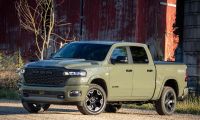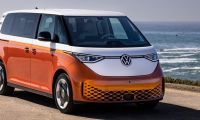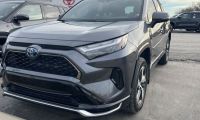Surely one of the more surprising revelations of the 2014 Paris Motor Show last week was the announcement that Chrysler will introduce a plug-in hybrid minivan in late 2015, about a year earlier than the company had previously suggested.
This electrified people-mover will allegedly reach fuel economy numbers in Toyota Prius territory, or 50 miles per gallon of gasoline. The fact that it will be released a full year earlier than Fiat-Chrysler had announced back in May is quite surprising given the company’s staunch opposition to all things electric.
Marchionne delivers on the skepticism yet again
Fiat-Chrysler CEO Sergio Marchionne is one of the more prominent skeptics of EV technology in automotive circles. He is well known for urging people not to buy the delightful Fiat 500e because his company loses $14,000 on each one.
Of course, along with the announcement of the fast-tracking of the plug-in hybrid minivan came the inevitable nugget of anti-EV wisdom from Marchionne (via Automotive News).
“I think you need to be very, very careful if you think that electrification, given its inherent limitations on range, especially in markets like the U.S., will effectively displace combustion,” he said. “It will never provide the travel distance that you require, especially based on what we know today about the storage capabilities of batteries.”
Marchionne went on to add: “I keep on running into this fundamental economic obstacle of overcoming the cost equation of electrification. You can’t. You can’t unless there is a wholesale change and a fundamental shift in the pricing structure of cars.”
Does he have a point?
The short answer is that yes, Marchionne does have a point. Batteries cannot hope to compete with gasoline in terms of sheer energy density, at least not as far into the future as we can reasonably speculate. This means that electric vehicles will continue to be inherently range-limited compared to their gasoline counterparts, or else will be hugely expensive or heavy.
The longer answer, of course, is far more complex.
Must electric vehicles duplicate the characteristics of gasoline competitors?
A very fundamental question underlying the entire shift to electrification, too often ignored or never asked in the first place, is this: do electric vehicles have to match the range and refueling capabilities of gasoline vehicles to reach the mass market?
As with many difficult questions, there is no universal answer. For the sake of brevity we will restrict our discussion to the United States market, where different types of electric cars can meet different American driver needs.
The Nissan LEAF, for example, is perfectly capable of meeting the needs of a huge proportion of the U.S. driving population. Studies and OEM customer research have made it quite clear that the vast majority of Americans drive fewer than 80 miles on all or most days. Though the LEAF is incapable of acting as a family hauler or viable road-trip vehicle, it is an excellent urban or commuter car.
The BMW i3 presents an interesting alternative, as it can bring a LEAF-like 81 miles of range or add a small gasoline range extender to increase effective range to roughly 150 miles. This, in addition to peace of mind, opens up the i3 to customers with longer commutes or the occasional day trip. It is worth noting here that more American buyers have opted for the range extender than have not.
The Chevrolet Volt, of course, is capable of effectively unlimited driving range thanks to its gasoline range extender. The 40 miles of all-electric range can cover most commutes or daily driving, with a total range of 380 miles once the gasoline backup kicks in. Many automakers are turning to plug-in hybrids to “meet customer needs” while providing some all-electric range for short trips. However, plug-in hybrids are generally expensive and complex thanks to their dual powertrains.
The Tesla Model S, on the other hand, comes closest to duplicating the capabilities of a gasoline vehicle in the form of a battery electric. Its 208- or 265-mile range coupled with the rapidly expanding Supercharger network, capable of restoring 170 miles of range in a half hour, means that Model S and future Tesla vehicles can for all intents and purposes imitate a gasoline vehicle on a road trip, albeit with longer and slightly more frequent refueling stops.
Back to Marchionne’s comments
It is reasonable to conclude that, to truly reach the mass market, electric vehicles have to narrow the gap between their own range and refueling characteristics and those of gasoline vehicles. The Tesla Model S represents an enormous step in the right direction, and plug-in hybrids allow electric day-to-day driving while still enabling long trips to meet the needs of most customers.
However, Model S remains beyond the price range of most Americans and plug-in hybrids bring premium price tags as well, many thousands of dollars greater than their humble gasoline siblings.
Scrutinizing the market today, Marchionne appears to be right in that electric vehicles are range-limited and would be prohibitively expensive and heavy if they were to equal the 400-500 mile range of most gasoline cars on the road. However, his statements and his “cost equation of electrification” appear to be extraordinarily short-sighted.
For one thing, the next few years will see the introduction of a number of electric vehicles with dramatically improved range over today’s models. Battery costs have fallen significantly since the LEAF and Volt kicked off the modern EV era in 2010 (from about $1,000/kWh to somewhere near $400/kWh for most manufacturers today, with the exception of Tesla) and will continue to do so, especially with the opening of Tesla’s Gigafactory in 2017 or 2018.
Marchionne also overlooks the fact that electric vehicles do not absolutely have to provide the same range as today’s gasoline cars. Even for the occasional long road trip, most humans are uncomfortable after driving 3-4 consecutive hours. This means a stop every 200-300 miles is perfectly reasonable – obviously, the issue of recharging times and necessary volume of DC fast chargers comes into play, but those barriers are being addressed with great urgency.
Then there are the positive attributes of electric vehicles that represent a sort of trade-off for higher cost and lower range than gasoline cars: a smoother, quieter and more refined driving experience, a lower center of gravity for better handling (in most EVs), more convenient “refueling” at home each night, lower maintenance costs and drastically lower fuel costs, and the bonus of greenhouse gas reduction – the typical electric vehicle driven on grid average electricity emits approximately half the carbon dioxide of the average gasoline car today.
Most consumers remain unaware of these benefits, however, and OEMs and their dealers by all accounts have left a lot to be desired in their education efforts. But that is an issue for another day.
So how much range is enough?
It is hard to say exactly how much range electric vehicles “need” to be truly practical and to reach the mass market, or how many DC fast chargers will be needed in what locations and with what kind of recharging times.
An example: even if battery costs reach the coveted $100/kWh target within a decade, a 300-mile electric vehicle would require roughly $10,000 worth of batteries. This is more than what the battery pack in the current Nissan LEAF, which starts at $29,000, is believed to cost. So for a long time, there will be an inevitable trade-off between range and MSRP.
Automakers will have to solve this equation of sticker price vs. driving range of electric vehicles to reach the greatest number of customers, and they have to do a lot more on the infrastructure side to improve the value proposition of their vehicles.
However, it is clear that electric vehicles, charging infrastructure, and battery technology are trending in the right direction – it is only a matter of time before EVs offer sufficient range and refueling characteristics to stage a fair fight with gasoline vehicles, at which point there will be no turning back.













Comments
I would say no, electric cars
Permalink
I would say no, electric cars do not have to have equivalent ICE characteristics, but they do need more range than they offer today, especially when you consider worst case scenarios of winter driving, detours, A/C usage, etc. For me, I would double my daily commute miles and say that 150 miles of EPA rated range would make me comfortable to handle the "what ifs". I would also hazard to guess that most driving families have more than one vehicle, so having your low commute cost electric and an ICE would not be unreasonable for many. That's what I would do if there were a reasonably priced electric option with 150 miles of range. Vehicles like the Soul EV are starting to get there and I anxiously await the 3rd gen Tesla with a lower price tag.
Yes, that is part of the
Permalink
Yes, that is part of the thing most people don't get, electric cars do not have to match gasoline cars. They can just be a better car altogether while still not matching in some respect. A feature phone lasts more in battery life than a smartphone and yet most of us use smartphone.
Also, an EV can technically beat a gasoline car in range. While energy density is important, with improved efficiency you get better range. If a Tesla battery had the energy density of gasoline, it would have 25,000 miles range. So even having 1/25th the energy density of gasoline would allow an electric car to beat a gas car on range. (though we need metal air batteries for that which are not close to commercialization). That said even with lithium ion we can do 400-500 miles range just fine. Just liek the Tesla Roadster upgrade battery that should get 400 miles range.
And I thought a Nissan Leaf battery was estimated to cost 9-18k? Remember, the battery replacement costs are not the same as current costs because they are based on future expected costs.
To add, you also can do a 300 mile EV without a 100kwh battery. It just depends on the size of the car. A Tesla Roadster could do 200 miles on a 53kwh battery due to being a smaller car. And if NHSTA allows for getting rid of mirrors, they can get better drag thus more efficiency. (though gas cars would benefit from that too)
A 300 mile range is more than
Permalink
A 300 mile range is more than what is needed for a practical EV. About 200 miles is adequate. 200 miles with 90% 20 recharging.
Drive 200, recharge 20 minutes, drive 180, pause 20 min, drive 180 mi. That 560 miles with two modest stops. Most people are going to stop a couple times on all day drives anyway. While charging you can eat a meal, walk the dog, return messages, grab a nap.
A hard pushing driver in an ICEV might cut it down to a 10 minute refuel/pee stop and eat the lunch they brought with them but that's now how most people drive. And even then they will arrive only a half hour earlier after a very long day of driving.
Most people will, I suspect, be willing to spend a little more time charging a very few days of the year than paying for the extra batteries to get to a 300 mile range. And paying for the energy to haul them around town.
Ask a non EV owner if they
Permalink
Ask a non EV owner if they should match conventional cars they will say yes, because they don't understand EV's and insisting on parity negates the need to understand EV's or change any behavior.
EV's do have different characteristics, and trying to make them more like gasoline cars can detract from the advantages of EV's. There are some minimum requirements to meet the needs of the driving public. Range is key and must improve to achieve widespread adoption, the 80 miles is OK may look good on paper, but all drivers instinctively know they drive over 120 miles in one day on occasion around town.
The public don't do well with total cost of ownership, they understand how much they need to pay today to own an EV, so price has to be comparable.
Once range and price are competitive, then adoption will build as the advantages of EV's are discovered and shared between drivers.
It is counterintuitive-
Permalink
It is counterintuitive--luxury autos will be EVs and budget autos will be EREVs.
A Tesla performs better than an equivelant ICE so that is what luxury car buyers care about. Once batteries are at $200 kWh then a Model S will have a 100 kWh pack and superchargers will charge at 150 kW, so a driver will be able to get 50 kWh in 20 minutes. So that equals 450 miles of 70 mph driving with one 20 minute stop.
Economy cars will be EREVs because 10 kWh of batteries allows the ICE to be downsized and most of the driving to be done on electricity...the next Volt will prove this design to be very popular and economical.
Actually EREVs may not be
Permalink
Actually EREVs may not be with us for too much longer. Rapidly falling battery prices are likely to make them less useful and make EVs cheaper. Take a look at how low battery prices force EREVs/PHEVs as well as hybrids off the market.
://thecleanrevolution.org/_assets/images/cache/autoxauto/2124.jpg
And it looks like battery prices are falling much faster than most of us anticipated. Navigant Research recently stated that Tesla is paying $180/kWh for their batteries from Panasonic. And that batteries could soon plunge to ~$100/kWh.
://reneweconomy.com.au/2014/battery-storage-costs-plunge-below100kwh-19365
Take a look on the graph at what that does to the car industry - batteries at <$200 and gas > $3/gallon. We may see affordable longer range EVs in our showrooms in the very near future and a major transformation of what people buy and drive.
The comments are as
Permalink
The comments are as informative as the article! Or perhaps better: This article generated some phenomenal discussion! The path to EV's is pretty clear!